The Bowers & Wilkins Px7 S2 headphones are supremely stylish and comfortable.
As evidenced by the “S2,” the Px7 S2 are the next evolution of the PX7 that were originally released at the end of 2019, with a mostly cosmetic upgrade (the Carbon Edition) in 2020. Bowers & Wilkins worked hard to improve upon the PX7 in any way it could, and the company succeeded.
The Px7 S2 are slimmer than previous models while keeping the design aesthetic the same. They also have a more dynamic sound profile and better noise canceling, though the latter can’t compete with top competitors. That said, for those after a stylish alternative to the status quo, the Px7 S2 make a lasting impression.
About the Bowers & Wilkins Px7 S2
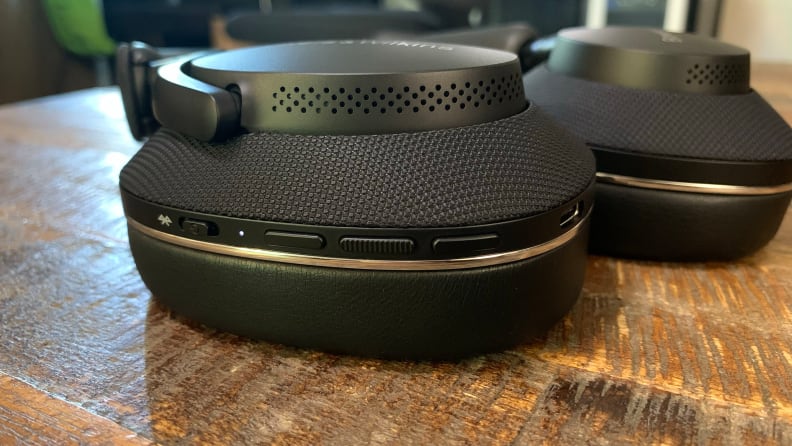
Credit: Reviewed / John Higgins
The button controls are easy to distinguish by feel when you wear the Px7 S2 headphones.
Here are the Bowers & Wilkins Px7 S2’s main specs:
- Price: $399
- Battery life: 30 hours
- Fast charging: 7 hours playback in 15 minutes (2 hours for full charge)
- Colors: Black, Blue, Gray
- Ambient sound modes: Active adaptive noise canceling, transparency mode
- Speakers: 40mm bio cellulose driver
- Microphones: 2 microphones for calling, 4 microphones for ANC
- Connectivity: USB-C Audio, Bluetooth 5.0
- Audio codecs: aptX Adaptive, aptX HD, aptX, AAC, SBC
- Dust/water resistance: No IP rating
- Passive operation: No (power required for audio)
- Weight: 307g
- Extras: Wear detection sensor
The Px7 S2 look remarkably similar to the Px7 with woven fabric accents on the top of the headband and the outside of the ear cups. There are only five buttons across both ear cups that are easy to differentiate by feel (touch controls are still not included). B&W has also done away with the 3.5mm plug, relying only on USB-C for wired audio and charging.
The ear cups can turn 90 degrees in either direction so they fold flat to fit nicely in their fabric-lined hardshell case. A compartment inside with a magnetic flap holds two 4-foot cables—a USB-C to 3.5mm cable for wired listening and a USB-C cable for charging. The case has a flat top and is slightly smaller than that of the Sony XM5, although still wider and longer than the XM4 case by a little under an inch in both directions.
What we like
Long-term comfort
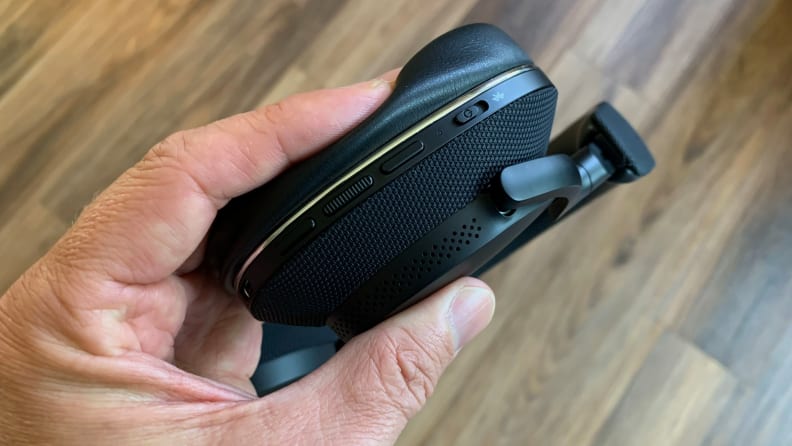
Credit: Reviewed / John Higgins
The cushy Px7 S2 pads feel luxurious.
Sometimes with higher-end headphones, companies focus primarily on sound, functionality, and style while comfort takes a backseat. Thankfully that isn’t the case with the Px7 S2. While their signature fashionable look has only undergone minor tweaks, B&W has taken care in improving the headphones’ long-term comfort. The design is slimmer and it’s easy to find a solid fit thanks to the ear cup swivel and telescoping.
There’s a fine balance between headache-inducing clamping force and enough stability to keep the headphones secure and sealed, and the Px7 S2 have managed to ride that line. At 307g, they’re 50g heavier than the Sony XM5 but 75g lighter than the Apple AirPods Max. I wore the Px7 S2’s for hours a day while testing, and the padding on the headband is cushy enough that the weight never pressured the top of my head.
The earcups padding is also nice and squishy, although a bit firmer than the Sony XM5, which I find to be the most comfortable headphones in this price range. The extra firmness does keep a nice seal, as long as you don’t wear glasses. When out wearing sunglasses, the pads weren’t able to fully seal around the temples, letting some of the outside world in. Thankfully the clamping force isn’t too much that it uncomfortably drives the glasses into the head.
Exceptional vocal clarity
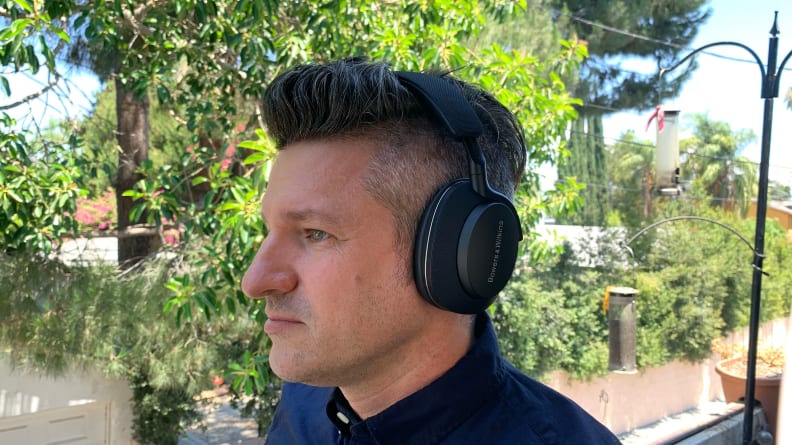
Credit: Reviewed / John Higgins
The Px7 S2’s sound profile is exciting and clear, especially in the vocal range.
Bowers & Wilkins has further improved upon its existing driver technology with the 40mm drivers and other components in the Px7 S2 to reduce the distortion levels from the PX7. Most interesting is the position of the drivers within the earcups. Taking inspiration from the flagship P9 Signature headphones, the drivers are toed in to better line up with the center of the ear. B&W says this improves tonal consistency and spatial placement.
Those improvements certainly come across with the Px7 S2. The overall sound balance is more restrained and true to content than the original PX7, which were both overly bassy and sizzly in the upper registers. High-end frequencies for the latest pair are exciting and sparkly without becoming piercing. They really ride that edge of being almost too much.
Where the Px7 S2 really shine is midrange clarity. Vocals and dialogue are crystal clear and present without being abrasive. The bass is more tamed, but at times—particularly with heavy bass tracks—it still draws too much attention to itself and clouds that vocal clarity.
With music in particular, the soundscape is wide and deep. Instruments within an orchestra have their own specific space to fill that matches where they sit on stage. Even with tighter mixes, like “Screenwriter’s Blues” on Soul Coughing’s iconic Ruby Vroom, the different instruments and sound occupy a distinct place. The added LP scratch moves in and out of Mike Doughty’s lyrics while different repetitive ideas fill the space. This is one case, though, where boomy lower frequencies like the bass drum and upright bass can cover the lyrics.
Unfortunately, the bass EQ adjustment in the B&W Music app isn’t targeted enough to address that bloat, instead dipping sounds below the bass drum. It also robs the overall sound of some body and heft.
Overall, though, the Px7 S2’s listening experience is top-notch and sound reproduction across the spectrum is delightfully engaging.
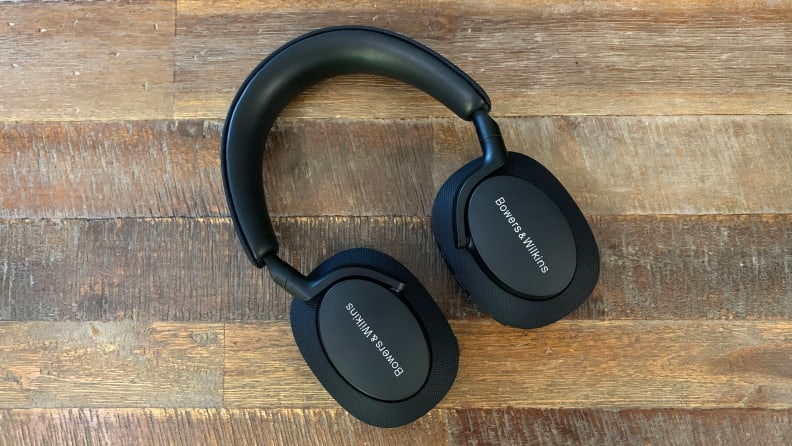
Credit: Reviewed / John Higgins
Both ear cups twist 90 degrees in either direction allowing the Px7 S2 headphones to lay flat.
What we don’t like
Noise canceling doesn’t measure up
With their luxurious feel, stylish look, and impressive sound, the Px7 S2 are poised to join the Sony XM5 and Apple Airpods Max as top-tier headphones choices, and in some ways they meet or surpass those models. I prefer the Px7’s styling and their case is a bit smaller than the XM5 and far more protective than the Airpods Max. Unfortunately, noise canceling capabilities don’t measure up and keep them from that lofty pedestal.
While the noise canceling has improved over the original Px7, its overall performance still doesn’t match what Sony, Apple, and Bose have been able to accomplish. They’re best with low-end droning sounds, such as air conditioners or airplane engines, although with less attenuation than competitors, but they don’t do much to cut out conversation or the higher frequencies like passing tire noise.
Most frustrating, though, is how directional the performance is. When the sound is right in front of me, the performance is best (particularly for those low drones), but as the sound moves around or I turn my head the ANC attenuation changes, letting in more sound. This phenomenon is not unheard of, although it usually plagues less expensive headphones and is something that doesn’t happen with the Sony XM5.
It’s most evident walking down the street with traffic whizzing by, hearing different frequencies pepper in and out as cars pass. Instead of isolating me from the changing world around me, it called my attention to it, albeit at a lower volume than with noise canceling off.
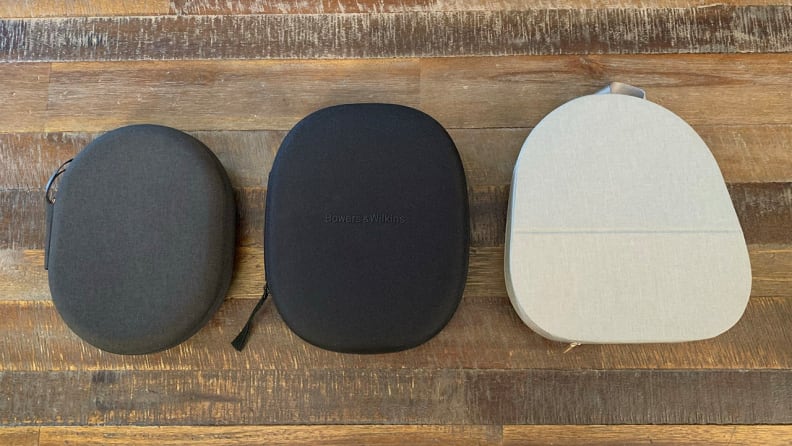
Credit: Reviewed / John Higgins
The Bowers & Wilkins Px7 S2’s case falls between the Sony XM4 and XM5 in terms of size.
App functionality is limited
The Px7 S2 use the same Bowers & Wilkins Music app as other B&W products, but the app is more limited with headphones. Apart from device management options (toggling auto standby, a wear sensor, or renaming how the headphones show in your product list), there are only three functional modifications that can be made.
B&W has added tone adjustments for a 6dB boost or cut to treble and bass. It’s a welcome addition, but too simplified for any fine-tuning to the sound profile, and the bass adjustment didn’t target the frequencies that bothered me most.
Meanwhile, noise canceling has been oversimplified. Now it’s just on, off, or transparency mode (labeled as passthrough), where previously there were different intensity levels to noise canceling. There’s also a toggle for the quick action button (located on the back of the left earcup) to choose either noise canceling control or voice assistant control.
Bowers & Wilkins has plans to expand the app’s functionality in the future, such as adding integrated music app control, but when that might happen is unknown. Plus, that doesn’t address the minimal EQ settings that are out of step with the competition. For comparison, Sony’s app is more robust, with a five-band EQ and variable noise canceling, among other useful features that B&W doesn’t provide. The potential is there, but the PX7 S2 don’t compete yet with what’s currently available in the marketplace.
Microphone is still flawed
Development was put into improving the call microphone quality by updating the microphone placement and voice capture technology. While it is better compared to the PX7, my voice still sounds boxy and a little distant.
When outside, passing traffic is inaudible to the other side of the call. Wind noise is mostly kept at bay, but that’s due to aggressive limiting that kicks in once the wind starts and can clip speaking as well. As the wind changes intensity, the limiter has a hard time consistently eliminating the noise. Instead, you hear blips of wind when it hits its peaks. The implementation is more distracting than helpful.
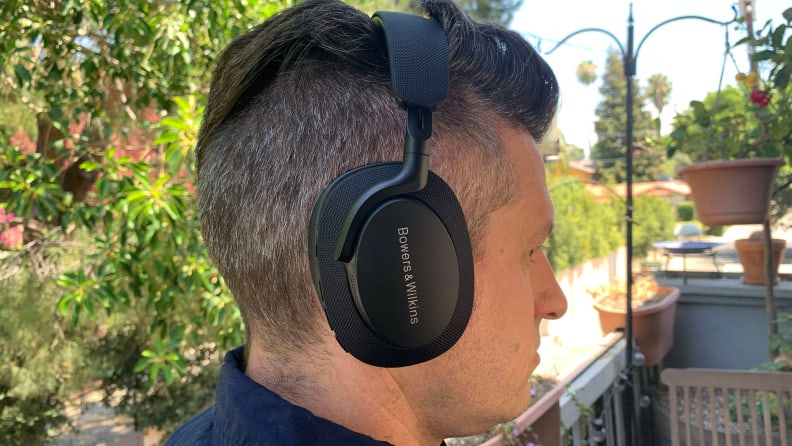
Credit: Reviewed / John Higgins
The Bowers & Wilkins Px7 S2 are incredibly comfortable to wear for long periods of time.
Should you buy the Bowers & Wilkins Px7 S2?
Yes, if their styling speaks to you
The Bowers & Wilkins Px7 S2 are excellent headphones that do many things really well. They’re comfortable over long periods of time thanks to cushy padding, their sound is exciting and engaging with excellent vocal clarity, and they’re incredibly stylish.
Taken on their own, the Px7 S2 are an immediate recommendation. But there are top-notch headphones available for similar pricing that outdo them. Out of the box, I prefer the sound of the Px7 S2 over the Sony WH-1000XM5, but with Sony’s app I can dial in an EQ that is perfectly suited to my listening preferences. Sony’s noise canceling is also much better than the Px7 S2 (as is Apple’s in the AirPods Max, though for $100 more). And even lower-priced cans like the top-rated Sony WH-1000XM4 and Bose’s QC45 get you better ANC.
The Px7 S2 win-out on looks—hands down, in my opinion. The slimmer shape, the woven fabric details, and the silver accents give them a look that’s both upscale and elegant. They aren’t the conventional choice for high-end wireless headphones, but they certainly are pretty and they deliver excellent sound quality.
The product experts at Reviewed have all your shopping needs covered. Follow Reviewed on Facebook, Twitter, Instagram, TikTok, or Flipboard for the latest deals, product reviews, and more.
Prices were accurate at the time this article was published but may change over time.
Meet the tester
John is the A/V Editor for Reviewed. Previously he’s had bylines at ProjectorCentral, Wirecutter, IGN, Home Theater Review, T3, Sound & Vision, and Home Theater Magazine.
Checking our work.
Our team is here for one purpose: to help you buy the best stuff and love what you own. Our writers, editors, and lab technicians obsess over the products we cover to make sure you’re confident and satisfied. Have a different opinion about something we recommend? Email us and we’ll compare notes.





